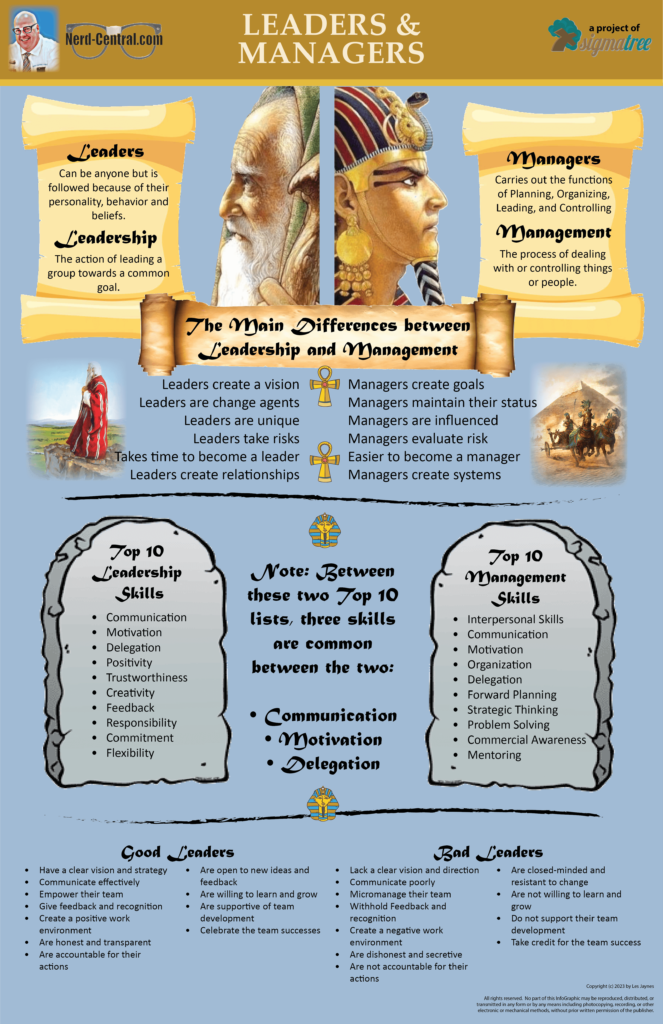OVERVIEW
Understanding the difference between a manager and a leader is key to any organization or entity. Both are needed but the expectations and outcomes are very different. Some people make better managers and others are better leaders. The talents and characteristics of both are clear and can be developed. At its core Leadership is about leading and requires a vision to guide change with the goal of getting people to follow. Whereas managers focus on achieving organizational goals through process implementation, such as budgeting, organizational structure, and staffing. Leaders are more concerned with thinking ahead and seizing opportunities. But to be perfectly clear, the best managers are also leaders. Most articles and diagrams lead you to believe that they are two distinct paths that can’t or don’t intertwine. Not the case at all.
Usually though managers and leaders are two different types of people. Managers’ goals usually arise out of necessities rather than desires; they excel at defusing conflicts between individuals or departments, focusing on all sides while ensuring that an organization’s day-to-day business gets done. Leaders, on the other hand, look for the opportunities and rewards that lie around the corner, inspiring subordinates and firing up the creative process with their own energy. Their relationships with employees and coworkers are intense, and their working environment is often chaotic. At the end of the day, organizations need both to survive and succeed.
Key aspects for both are as follows:
- Leadership is the action of leading a group towards a common goal.
- Manager is the process of dealing with or controlling things or people.
- Leaders focus on inspiring, motivating, and encouraging.
- Managers focus on planning, organizing and coordinating.
- The key skills of a Leader are: Communication, Motivation, Delegation, Positivity, Trustworthiness, Creativity, Feedback, Responsibility, Commitment, and Flexibility.
- The key skills of a Manager are: Interpersonal Skills, Communication, Motivation, Organization, Delegation, Forward Planning, Strategic Thinking, Problem Solving, Commercial Awareness, Mentoring.
Notice that both the Leader and the Manager will have the combined skills of Communication, Motivation, and Delegation but for the manager, those three skills are not at the top of the list.
These thoughts and concepts have been summarized in the below infographic which uses Moses and Ramesses as an example of a Leader and a Manager. Following the infographic is more detailed information as it relates to the topic of Leaders/Leadership and Managers/Management.

MORE DETAIL
So… What is Leadership?
Leadership is the creation of positive, non-incremental change through meticulous planning, vision, and strategy. Workforce empowerment and adaptive decision-making also add up to the crucial attributes of leadership. Most often, people relate leadership with one’s position in an organization. But leadership has nothing to do with titles, management, or one’s personal agendas. It’s also not restricted to personality traits such as better vision or charismatic personality.
It is more like a process of social influence, which maximizes the efforts of others toward the achievement of a common goal. It stems from social influence and requires human resources to achieve the intended outcomes. A leader is someone who always takes the initiative and invests a great effort to accomplish the company’s vision. That is the only reason why people around them start following them.
And… What is Management?
Management is all about performing pre-planned tasks on a regular basis with the help of subordinates. A manager is completely responsible for carrying out the four important functions of management: planning, organizing, leading, and controlling. Managers can only become leaders if they adequately carry out leadership responsibilities, including communication of the good and the bad, providing inspiration and guidance, and encouraging employees to rise to a higher level of productivity.
But, unfortunately, not all managers can achieve that. Managerial responsibilities are often outlined in a job description, with subordinates following because of the professional title or classification. A manager’s primary focus is on meeting organizational goals; they often do not take much else into consideration. With the title comes the authority and the privilege to promote, hire, or reward employees based on their performance and behavior.
What is the major difference between leadership and management?
Leadership and management are different from each other in many ways, however, the major difference between them is that management is a group of entities that work to accomplish a goal. Whereas, the leadership takes care of motivating, influencing, and empowering employees. Influence and inspiration separate leaders from managers, not power and control.
Difference Between Leadership vs Management
The role of management is to control a group or group of individuals in order to achieve a specified objective. Leadership is the ability of an individual to influence, motivate, and enable others to contribute to the organization’s success.
Management is responsible for controlling an organization, a group, or a set of entities to achieve a particular objective. Managing is about making sure the day-to-day operations are being performed as expected. A leader communicates in order to set direction, inspire, and motivate their team.
Leadership requires a vision to guide change. Whereas managers focus on achieving organizational goals through process implementation, such as budgeting, organizational structure, and staffing, leaders are more concerned with thinking ahead and seizing opportunities.
What are the 6 differences between leadership and management?
- Leaders create a vision, managers create goals.
- Leaders are change agents, managers maintain their status..
- Leaders are unique, managers are influenced
- Leaders take risks, managers evaluate risk
- It takes time to become a leader, but it is easier to become a manager
- Leaders create relationships, managers create systems.
It is possible to be a manager and a leader at the same time. But keep in mind that just because someone is a great leader doesn’t mean they’ll be a great manager or the other way around. So, what factors distinguish these two roles?
1. Differences in Vision
Leaders are considered visionaries. They set the pathways to excel the organizational growth. They always examine where their organization stands, where they want to go, and how they can reach their goals by involving the team. In comparison, managers set out to achieve organizational goals by implementing processes, such as budgeting, organizational structuring, and staffing. Managers’ vision is bound to the implementation strategies, planning, and organizing tasks to reach the objectives set out by leaders. However, both of these roles are equally important in the context of business environments and necessitate associative efforts.
2. Organizing vs Aligning
Managers achieve their goals by using coordinated activities and tactical processes. They break down long-time goals into tiny segments and organize available resources to reach the desired outcome. On the other hand, leaders are more concerned with how to align and influence people than how to assign work to them. They achieve this by assisting individuals in envisioning their function in a wider context and the possibility for future growth that their efforts may give.
3. Differences in Queries
A leader asks what and why, whereas a manager focuses on the questions of how and when. To do justice to their duties as a leader, one might question and challenge the authority to reverse decisions that may not be in the best interest of the team. If a firm has a stumbling block, a leader will be the one to step up and ask, What did we learn from this? and Why has this happened? On the other hand, managers are not required to assess and analyze failures. Their job description emphasizes asking How and When, which assists them in ensuring that plans are carried out correctly. They prefer to accept the status quo and make no attempt to change it.
4. Position vs Quality
A manager is a role that frequently refers to a specific job within an organization’s structure, whereas the term leader has a more ambiguous definition. Leadership emerges as a result of your actions. You are a leader if you act in a way that inspires others to do their best. It makes no difference what your title or position is. On the other hand, a manager is a job title that comes with a fixed set of responsibilities.
Important Distinctions
When employees are promoted into a role where they are going to manage people, they don’t automatically become a leader. There are important distinctions between managing and leading people.
What is the difference between management and leadership?
Leadership focuses on motivating employees, making them believe in your vision and setting the right work culture at the company. On the other hand, management stresses day-to-day task progress and related issues.
Leaders create a vision – Managers create goals.
Leaders paint a picture of what they see as possible and inspire and engage their people in turning that vision into reality. They think beyond what individuals do. They activate people to be part of something bigger. They know that high-functioning teams can accomplish a lot more working together than individuals working autonomously. Whereas managers focus on setting, measuring, and achieving goals. They control situations to reach or exceed their objectives.
Leaders are change agents – Managers maintain the status quo.
Leaders are proud disrupters. Innovation is their mantra. They embrace change and know that even if things are working, there could be a better way forward. They understand and accept the fact that changes to the system often create waves. Managers stick with what works, refining systems, structures and processes to make them better.
Leaders are unique – Managers copy.
Leaders are willing to be themselves. They are self-aware and work actively to build their unique and differentiated personal brand. They are comfortable in their own shoes and willing to stand out. They’re authentic and transparent. Managers mimic the competencies and behaviors they learn from others and adopt their leadership style rather than defining it.
Leaders take risks – Managers control risk.
Leaders are willing to try new things even if they may fail miserably. They know that failure is often a step on the path to success. Managers work to minimize risk. They seek to avoid or control problems rather than embracing them.
Leaders are in it for the long haul – Managers think short-term.
Leaders have intentionality. They do what they say they are going to do and stay motivated toward a big, often very distant goal. They remain motivated without receiving regular rewards. Managers work on shorter-term goals, seeking more regular acknowledgment or accolades.
Leaders grow personally – Managers rely on existing, proven skills.
Leaders know if they aren’t learning something new every day, they aren’t standing still, they’re falling behind. They remain curious and seek to remain relevant in an ever-changing world of work. They seek out people and information that will expand their thinking. Managers often double down on what made them successful, perfecting existing skills and adopting proven behaviors.
Leaders build relationships – Managers build systems and processes.
Leaders focus on people – all the stakeholders they need to influence in order to realize their vision. They know who their stakeholders are and spend most of their time with them. They build loyalty and trust by consistently delivering on their promise. Managers focus on the structures necessary to set and achieve goals. They focus on the analytical and ensure systems are in place to attain desired outcomes. They work with individuals and their goals and objectives.
Leader’s coach – Managers direct.
Leaders know that people who work for them have the answers or are able to find them. They see their people as competent and are optimistic about their potential. They resist the temptation to tell their people what to do and how to do it. Managers assign tasks and provide guidance on how to accomplish them.
Leaders create fans – Managers have employees.
Leaders have people who go beyond following them; their followers become their raving fans and fervent promoters – helping them build their brand and achieve their goals. Their fans help them increase their visibility and credibility. Managers have staff who follow directions and seek to please the boss.
What are the Similarities Between Leadership and Management?
There are many ways in which management and leadership are comparable. Both require establishing objectives, coming up with strategies to get there, and tracking the development. Both demand collaboration with others, effective communication, decision-making, problem-solving, strategic thinking, and accountability in order to succeed. Managers and leaders are responsible for gathering data, weighing options, and making decisions that will benefit their team or company. Additionally, they must accept accountability for their deeds and be open and honest about them. In general, effective leadership and management require a combination of these skills because they share many essential qualities.
Which is better, management or leadership?
Both management and leadership are naturally crucial for the smooth working of an organization. But leadership is ahead of the management — a well-balanced organizational leadership in the core. Discipline, vision, and passion are essential to building a successful business.
What Do Managers Do?
A manager is a member of an organization with the responsibility of carrying out the four important functions of management: planning, organizing, leading, and controlling. But are all managers leaders? Most managers also tend to be leaders, but only IF they also adequately carry out the leadership responsibilities of management, which include communication, motivation, providing inspiration and guidance, and encouraging employees to rise to a higher level of productivity. Unfortunately, not all managers are leaders. Some managers have poor leadership qualities, and employees follow orders from their managers because they are obligated to do so—not necessarily because they are influenced or inspired by the leader.
Managerial duties are usually a formal part of a job description; subordinates follow as a result of the professional title or designation. A manager’s chief focus is to meet organizational goals and objectives; they typically do not take much else into consideration. Managers are held responsible for their actions, as well as for the actions of their subordinates. With the title comes the authority and the privilege to promote, hire, fire, discipline, or reward employees based on their performance and behavior.
What Do Leaders Do?
The primary difference between management and leadership is that leaders don’t necessarily hold or occupy a management position. Simply put, a leader doesn’t have to be an authority figure in the organization; a leader can be anyone. Unlike managers, leaders are followed because of their personality, behavior, and beliefs. A leader personally invests in tasks and projects and demonstrates a high level of passion for work. Leaders take a great deal of interest in the success of their followers, enabling them to reach their goals to satisfaction—these are not necessarily organizational goals. There isn’t always tangible or formal power that a leader possesses over his followers. Temporary power is awarded to a leader and can be conditional based on the ability of the leader to continually inspire and motivate their followers.
NOTE
A difference in terminologies – a Manager has “Subordinates”, while a Leader has “Followers”.
Subordinates of a manager are required to obey orders while following is optional when it comes to leadership. Leadership works on inspiration and trust among employees; those who do wish to follow their leader may stop at any time. Generally, leaders are people who challenge the status quo. Leadership is change-savvy, visionary, agile, creative, and adaptive.
How to Measure Effective Leadership?
Considering this certain leadership is an individualized and multifaceted concept, measuring successful leadership can be challenging. Assessing employee engagement, turnover rates, and performance metrics are a few typical methods to gauge effective leadership. Effective leaders are adept at fostering a positive work atmosphere and building trusting relationships with their team, which results in high employee engagement levels and reduced turnover rates. A leader’s capacity to hit performance benchmarks and realize organizational objectives can also be used to gauge their efficiency. The efficiency of a leader can also be evaluated through regular performance reviews, 360-degree assessments, and feedback from stakeholders and employees.
How to Measure Effective Management?
A number of variables, such as employee satisfaction, productivity, efficiency, and financial performance, can be used to gauge efficient management. High-performing teams should be easy to create and manage, effective delegation of tasks, clear goals and expectations, and the adoption of efficient procedures are all skills that successful managers should possess. A manager’s efficiency can be evaluated using key performance indicators (KPIs) like sales figures, customer satisfaction ratings, and production rates. Additionally helpful sources of information about a manager’s success include employee feedback, 360-degree evaluations, and routine performance reviews. In the end, a manager should be able to drive outcomes while fostering a good workplace culture and supporting employee growth.
Which is more important, leadership or management?
Both leaders and managers are important to run a successful business. Leadership ensures the overall values and ethics of the organization, whereas managers structure teams to achieve targets.
How to Develop Leadership and Management Skills?
There are various methods for honing management and leading abilities. One method is to look for formal education and training programs, such as management development programs or business courses. Another method is to participate in volunteer work, internships, or projects as a leader to gain real-world experience. It can also be helpful to find areas for improvement by asking for feedback from mentors, peers, and colleagues. Developing self-awareness and emotional intelligence can also improve leadership and management abilities. Keeping up with industry trends and networking with other pros can also present chances to pick up new insights and learn from others. Practice, feedback, and continuous learning are essential to developing effective leadership and management skills.
What are the two key differences between leadership and management?
The 2 key differences between leadership and management are –
Leadership creates values, management counts those values.
Leadership leads people, management manages the work people do.
What are the Traits a Manager Possesses?
Below are four important traits of a manager:
- The Ability to Execute a Vision
Managers build a strategic vision and break it down into a roadmap for their team to follow. - The Ability to Direct
Managers are responsible for day-to-day efforts while reviewing necessary resources and anticipating the need to make changes along the way. - Process Management
Managers have the authority to establish work rules, processes, standards, and operating procedures. - People Focused
Managers are known to look after and cater to the needs of the people they are responsible for: listening to them, involving them in certain key decisions, and accommodating reasonable requests for change to contribute to increased productivity.
What are the Traits a Leader Possesses?
Below are five important traits of a leader:
- Vision
A leader knows where they stand, where they want to go and tend to involve the team in charting a future path and direction. - Honesty and Integrity
Leaders have people who believe them and walk by their side down the path the leader sets. - Inspiration
Leaders are usually inspirational—and help their team understand their own roles in a bigger context. - Communication Skills
Leaders always keep their team informed about what’s happening, both present and the future—along with any obstacles that stand in their way. - Ability to Challenge
Leaders are those that challenge the status quo. They have their style of doing things and problem-solving and are usually the ones who think outside the box.
The Three Important Differences Between a Manager and a Leader
Being a manager and a leader at the same time is a viable concept. But remember, just because someone is a phenomenal leader, it does not necessarily guarantee that the person will be an exceptional manager as well, and vice versa. So, what are the standout differences between the two roles?
- A Leader Invents or Innovates While a Manager Organizes
The leader of the team comes up with new ideas and kickstarts the organization’s shift or transition to a forward-thinking phase. A leader always has his or her eyes set on the horizon, developing new techniques and strategies for the organization. A leader has immense knowledge of all the current trends, advancements, and skillsets—and has a clarity of purpose and vision. By contrast, a manager is someone who generally only maintains what is already established. A manager needs to watch the bottom line while controlling employees and workflow in the organization and preventing any chaos. - A Manager Relies on Control, whereas a Leader Inspires Trust:
A leader is a person who pushes employees to do their best and knows how to set an appropriate pace and tempo for the rest of the group. Managers, on the other hand, are required by their job description to establish control over employees, which, in turn, helps them develop their assets to bring out their best. Thus, managers have to understand their subordinates well to do their job effectively.
- A Leader Asks the Questions “What” and “Why”, Whereas a Manager Leans More Toward the Questions “How” and “When”:
To be able to do justice to their role as a leader, some may question and challenge authority to modify or even reverse decisions that may not have the team’s best interests in mind. Good leadership requires a great deal of good judgment, especially when it comes to the ability to stand up to senior management over a point of concern or if there is an aspect in need of improvement. If a company goes through a rough patch, a leader will be the one who will stand up and ask the question: “What did we learn from this? ” Managers, however, are not required to assess and analyze failures. Their job description emphasizes asking the questions “how” and “when,” which usually helps them make sure that plans are properly executed. They tend to accept the status quo exactly the way it is and do not attempt a change.
NOTE
The Best Managers are also Leaders!
Good Leader Bad Leader
As a leader, there are very distinct traits that make up a “Good” leader (successful) and a “Bad” leader (not so much). These two lists summarize the actions and traits that they should either work on and embrace or… work to shed and remove from their repertoire.
| Good Leader | Bad Leader |
| Have a clear vision and strategy | Lack a clear vision and direction |
| Communicate effectively | Communicate poorly |
| Empower their team | Micromanage their team |
| Give feedback and recognition | Withhold feedback and recognition |
| Create a positive work environment | Create a negative work environment |
| Are honest and transparent | Are dishonest and secretive |
| Are accountable for their actions | Are not accountable for their actions |
| Are open to new ideas and feedback | Are closed-minded and resistant to change |
| Are willing to learn and grow | Are not willing to learn and grow |
| Are supportive of team development | Do not support their team development |
| Celebrate the team successes | Take credit for the team successes |
The Three Tests
- Counting Value vs. Creating Value:
Managers are the only ones who count value. There are some who cut down on the value by disabling or otherwise countering ideas and people who add value.
Leaders, however, focus instead on working to generate a certain value that is over and above that which the team creates—and is as much a creator of value as their followers. Leading by example and leading by enabling people are the hallmarks of action-based leadership.
- Circles of Influence vs. Circles of Power:
As mentioned previously, managers have subordinates and leaders gain followers, which implies that managers create a circle of power while leaders create a circle of influence. The quickest way to figure out which of the two you’re doing is to count the number of people outside your reporting hierarchy who come to you for advice. The more that do, the more likely it is that you are perceived to be a leader.
- Leading People vs. Managing People:
One responsibility of a manager is controlling a group in order to accomplish a specific goal. Leadership, on the other hand, is the ability of an individual to motivate, influence, and enable other employees to make a contribution to the success of an organization. Inspiration and influence separate leaders from managers—not control and power.
FINAL DEDUCTION
Leading and managing are two contrasting ways of making employees work together more efficiently. Leadership is a spearhead for the new vision and initiatives, whereas management controls the resources effectively to bring those visions into the realm of reality. With the passing of time, you can shape your leadership skills by developing emotional intelligence and learning how to influence others.
What comes first, leadership or management?
Leadership comes first as they drive the organization with their vision.




